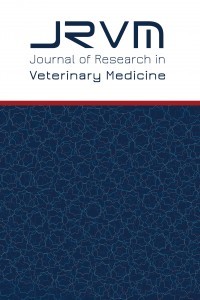İvermektinin Küçük Ruminant Vebası (PPR) Virusuna Karşı İn Vitro Antiviral Etkinliği
İvermektin, Antiviral etkinlik, İn vitro test, Peste des petits ruminants virus, PPR
In Vitro Antiviral Efficiency of İvermectin Against Peste des Petits Ruminants (PPR) Virus
Ivermectin, Antiviral efficiency, In vitro testing, Peste des petits ruminants virus, PPR,
___
- OIE. Peste des Petits Ruminants. Cent Food Secur Public Heal. Published online 2015:1-5. https://www.cfsph.iastate.edu/
- OIE, FAO. Global Strategy for the Control and Eradication of PPR.; 2015.
- ICTV. Taxonomic Information-International Committee on Taxonomy of Viruses. https://talk.ictvonline.org/.
- Muniraju M, Munir M, Parthiban AR, et al. Molecular evolution of peste des petits ruminants virus. Emerg Infect Dis. 2014;20(12):2023-2033. doi:10.3201/eid2012.140684
- ViralZone. SIB Swiss Institute of Bioinformatics. https://viralzone.expasy.org/.
- Baron MD, Parida S, Oura CAL. Peste des petits ruminants: A suitable candidate for eradication? Vet Rec. 2011;169(1):16-21. doi:10.1136/vr.d3947
- Kgotlele T, Chota A, Chubwa CC, et al. Detection of peste des petits ruminants and concurrent secondary diseases in sheep and goats in Ngorongoro district, Tanzania. Comp Clin Path. 2019;28(3):755-759. doi:10.1007/s00580-018-2848-5
- Zhao H, Njeumi F, Parida S, Benfield CTO. Progress towards eradication of peste des petits ruminants through vaccination. Viruses. 2021;13(1):1-15. doi:10.3390/v13010059
- Campbell WC, Fisher MH, Stapley EO, Albers-Schonberg G, Jacob TA. Ivermectin: a potent new antiparasitic agent. Science (80- ). 1983;221(4613):823-828. http://www.sciencemag.org/cgi/content/abstract/221/4613/823
- Wagstaff KM, Sivakumaran H, Heaton SM, Harrich D, Jans DA. Ivermectin is a specific inhibitor of importin α/β-mediated nuclear import able to inhibit replication of HIV-1 and dengue virus. Biochem J. 2012;443(3):851-856. doi:10.1042/BJ20120150
- Yang SNY, Atkinson SC, Wang C, et al. The broad spectrum antiviral ivermectin targets the host nuclear transport importin α/β1 heterodimer. Antiviral Res. 2020;177(December 2019):104760. doi:10.1016/j.antiviral.2020.104760
- Azeem S, Ashraf M, Rasheed MA, Anjum AA, Hameed R. Evaluation of cytotoxicity and antiviral activity of ivermectin against Newcastle disease virus. Pak J Pharm Sci. 2015;28(2):597-602.
- Mastrangelo E, Pezzullo M, De burghgraeve T, et al. Ivermectin is a potent inhibitor of flavivirus replication specifically targeting NS3 helicase activity: New prospects for an old drug. J Antimicrob Chemother. 2012;67(8):1884-1894. doi:10.1093/jac/dks147
- Caly L, Druce JD, Catton MG, Jans DA, Wagstaff KM. The FDA-approved drug ivermectin inhibits the replication of SARS-CoV-2 in vitro. Antivir Res J. 2020;178(January):104787.
- Afzal S, Raza S, Rabbani M, Firyal S, Altaf I, Naeem Z. Antiviral Potential of Ivermectin against Peste des Petits Ruminants Virus (PPRV). Pakistan J Zool. Published online 2021:1-4. doi:https://dx.doi.org/10.17582/journal.pjz/20200704060712
- Naeem Z, Raza S, Afzal S, Sheikh AA, Ali MM, Altaf I. Antiviral potential of ivermectin against foot-and-mouth disease virus, serotype O, A and Asia-1. Microb Pathog. 2021;155(April):104914. doi:10.1016/j.micpath.2021.104914
- Yesilbag K, Toker EB, Ates O. Ivermectin also inhibits the replication of bovine respiratory viruses (BRSV, BPIV-3, BoHV-1, BCoV and BVDV) in vitro. Virus Res. 2021;297(December 2020):198384. doi:10.1016/j.virusres.2021.198384
- Lv C, Liu W, Wang B, et al. Ivermectin inhibits DNA polymerase UL42 of pseudorabies virus entrance into the nucleus and proliferation of the virus in vitro and vivo. Antiviral Res. 2018;159(August):55-62. doi:10.1016/j.antiviral.2018.09.010
- Raza S, Shahin F, Zhai W, et al. Ivermectin inhibits bovine herpesvirus 1 DNA polymerase nuclear import and interferes with viral replication. Microorganisms. 2020;8(3):1-15. doi:10.3390/microorganisms8030409
- Varghese FS, Kaukinen P, Gläsker S, et al. Discovery of berberine, abamectin and ivermectin as antivirals against chikungunya and other alphaviruses. Antiviral Res. 2016;126:117-124. doi:10.1016/j.antiviral.2015.12.012
- Başlangıç: 1981
- Yayıncı: Bursa Uludağ Üniversitesi
Tuğçe Necla SELVİ, Hakan ÜSTÜNER
Emin KARAKURT, Uğur AYDIN, Enver BEYTUT, Serpil DAĞ, Celal Şahin ERMUTLU, Özgür AKSOY, Hilmi NUHOĞLU, Ayfer YILDIZ, Emre KURTBAŞ
Gökçen GÜVENÇ, Gözde ARSLAN, Mehmet KARAÇAY, Diğdem YÖYEN ERMİŞ, Efe ÖZOĞLU, Barbaros ORAL, Murat YALÇIN
Aseel Tavuklarda (Gallus domesticus) Pecten Oculi’nin Işık ve Elektron Mikroskopik Özellikleri
İvermektinin Küçük Ruminant Vebası (PPR) Virusuna Karşı İn Vitro Antiviral Etkinliği
Eda Baldan TOKER, Özer ATEŞ, Kadir YEŞİLBAĞ
Selim ALÇAY, Selvinar SEVEN-ÇAKMAK, Ahmet AKTAR, İbrahim ÇAKMAK
